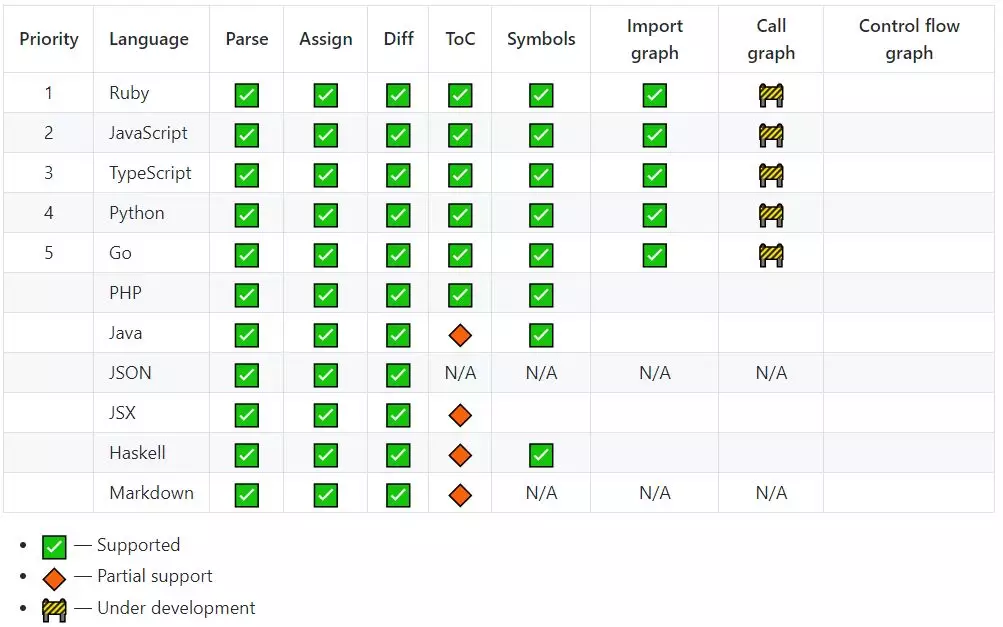我在GitHub上又找到一個(gè)堪稱(chēng)神器的命令行工具
GitHub上的實(shí)用工具還是挺多的,這不,又讓我找到了一個(gè)堪稱(chēng)神器的支持多語(yǔ)言的命令行工具——Semantic,Semantic是一個(gè)解析,分析和比較多種語(yǔ)言源代碼的命令行工具,也是一個(gè)Haskell庫(kù)。
平常解析源代碼也算是程序員的家常便飯了,如果有個(gè)工具幫你一把那是最好不過(guò)的了,Semantic具體如何使用,猿妹下面一說(shuō)你就明白了:
首先呢,運(yùn)行semantic --help獲取最新的完整選項(xiàng)列表:
解析
- Usage: semantic parse ([--sexpression] | [--json] | [--json-graph] | [--symbols]
- | [--dot] | [--show] | [--quiet]) [FILES...]
- Generate parse trees for path(s)
- Available options:
- --sexpression Output s-expression parse trees (default)
- --json Output JSON parse trees
- --json-graph Output JSON adjacency list
- --symbols Output JSON symbol list
- --dot Output DOT graph parse trees
- --show Output using the Show instance (debug only, format
- subject to change without notice)
- --quiet Don't produce output, but show timing stats
Semantic使用樹(shù)形圖來(lái)生成解析樹(shù),現(xiàn)在我們拿一個(gè)簡(jiǎn)單的程序來(lái)解析你會(huì)看的更明了,打開(kāi)test.A.py文件,粘貼如下:
- def Foo(x):
- return x
- print Foo("hi")
現(xiàn)在,讓我們生成一個(gè)抽象語(yǔ)法樹(shù)(AST)
- $ semantic parse test.A.py
- (Statements
- (Annotation
- (Function
- (Identifier)
- (Identifier)
- (Return
- (Identifier)))
- (Empty))
- (Call
- (Identifier)
- (Call
- (Identifier)
- (TextElement)
- (Empty))
- (Empty)))
默認(rèn)的s-expression輸出是一種很好的格式,可以快速可視化代碼結(jié)構(gòu)。我們可以看到有一個(gè)聲明的函數(shù),然后有一個(gè)調(diào)用表達(dá)式,嵌套在另一個(gè)調(diào)用表達(dá)式中,它與函數(shù)調(diào)用print和Foo。你還可以使用其他的輸出格式。
DIFF(比較)
- Usage: semantic diff ([--sexpression] | [--json] | [--json-graph] | [--toc] |
- [--dot] | [--show]) [FILE_A] [FILE_B]
- Compute changes between paths
- Available options:
- --sexpression Output s-expression diff tree (default)
- --json Output JSON diff trees
- --json-graph Output JSON diff trees
- --toc Output JSON table of contents diff summary
- --dot Output the diff as a DOT graph
- --show Output using the Show instance (debug only, format
- subject to change without notice)
Graph(圖)
- Usage: semantic graph ([--imports] | [--calls]) [--packages] ([--dot] | [--json]
- | [--show]) ([--root DIR] [--exclude-dir DIR]
- DIR:LANGUAGE | FILE | --language ARG (FILES... | --stdin))
- Compute a graph for a directory or from a top-level entry point module
- Available options:
- --imports Compute an import graph (default)
- --calls Compute a call graph
- --packages Include a vertex for the package, with edges from it
- to each module
- --dot Output in DOT graph format (default)
- --json Output JSON graph
- --show Output using the Show instance (debug only, format
- subject to change without notice)
- --root DIR Root directory of project. Optional, defaults to
- entry file/directory.
- --exclude-dir DIR Exclude a directory (e.g. vendor)
- --language ARG The language for the analysis.
- --stdin Read a list of newline-separated paths to analyze
- from stdin.
語(yǔ)言支持
多語(yǔ)言支持是Semantic的一大優(yōu)勢(shì),目前支持Ruby、JavaScript、typescript、Python、Go、PHP、Java等主流編程語(yǔ)言都支持
Semantic最低要求GHC 8.6.4和Cabal 2.4,建議使用ghcup沙箱GHC版本,為通過(guò)操作系統(tǒng)的軟件包管理器安裝的GHC軟件包可能無(wú)法安裝靜態(tài)鏈接版本的GHC啟動(dòng)庫(kù)。
- git clone git@github.com:github/semantic.git
- cd semantic
- script/bootstrap
- cabal new-build
- cabal new-test
- cabal new-run semantic -- --help
創(chuàng)建者使用cabal的Nix風(fēng)格的本地版本進(jìn)行開(kāi)發(fā)。要快速入門(mén),可以按照以上操作。
目前,semantic已經(jīng)在GitHub上獲得 8000 個(gè)Star,450 個(gè)Fork,感興趣的可以到GitHub上查閱更多詳情
(GitHub地址:https://github.com/github/semantic)。




































